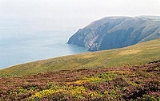
Exmoor Coastal Heaths
Encyclopedia
Exmoor Coastal Heaths is a 1758.3 hectare
(4344.7 acre) biological Site of Special Scientific Interest in Devon
and Somerset
, notified in 1994.
This site lies within the Exmoor National Park, and contains extensive areas of heathland communities. Associated particularly
with the coastal communities and woods are a wide range of nationally rare and scarce plants. The site comprises four separate blocks (between Combe Martin
and Minehead
) centred on Trentishoe
, Cosgate Hill, Countisbury and North Hill. There are two nationally rare, endemic Whitebeam
species which occur in the woodland areas namely Sorbus subcuneata
and Sorbus vexans
. Several nationally scarce plant
species are found within this site; White Mullein (Verbascum lychnitis) in its yellow form occurs in fields at the edge of the site, Cornish Moneywort Sibthorpia europaea beside streams, Rock Stonecrop Sedum forsteranum on rocky seacliffs and Sea Storksbill (Erodium maritinum), Upright Chickweed
(Moenchia erecta) and Bird's-foot Clover (Trifolium ornithopodioides) all in areas of very short turf. A nationally rare butterfly
the High Brown Fritillary
(Argynnis adippe) occurs on this site.
Hectare
The hectare is a metric unit of area defined as 10,000 square metres , and primarily used in the measurement of land. In 1795, when the metric system was introduced, the are was defined as being 100 square metres and the hectare was thus 100 ares or 1/100 km2...
(4344.7 acre) biological Site of Special Scientific Interest in Devon
Devon
Devon is a large county in southwestern England. The county is sometimes referred to as Devonshire, although the term is rarely used inside the county itself as the county has never been officially "shired", it often indicates a traditional or historical context.The county shares borders with...
and Somerset
Somerset
The ceremonial and non-metropolitan county of Somerset in South West England borders Bristol and Gloucestershire to the north, Wiltshire to the east, Dorset to the south-east, and Devon to the south-west. It is partly bounded to the north and west by the Bristol Channel and the estuary of the...
, notified in 1994.
This site lies within the Exmoor National Park, and contains extensive areas of heathland communities. Associated particularly
with the coastal communities and woods are a wide range of nationally rare and scarce plants. The site comprises four separate blocks (between Combe Martin
Combe Martin
Combe Martin is a village and civil parish on the North Devon coast about east of Ilfracombe. It is a small seaside resort with a sheltered cove on the edge of the Exmoor National Park...
and Minehead
Minehead
Minehead is a coastal town and civil parish in Somerset, England. It lies on the south bank of the Bristol Channel, north-west of the county town of Taunton, from the border with the county of Devon and in proximity of the Exmoor National Park...
) centred on Trentishoe
Trentishoe
thumb|220px|The Trentishoe area on Donn's one inch to the mile survey of 1765.Trentishoe is a village in North Devon, England. It is in the Shirwell deanery of the Church of England...
, Cosgate Hill, Countisbury and North Hill. There are two nationally rare, endemic Whitebeam
Whitebeam
The whitebeams are members of the Rosaceae family, comprising subgenus Aria of genus Sorbus, and hybrids involving species of this subgenus and members of subgenera Sorbus, Torminaria and Chamaemespilus. They are deciduous trees with simple or lobed leaves, arranged alternately...
species which occur in the woodland areas namely Sorbus subcuneata
Sorbus subcuneata
Sorbus subcuneata is a species of plant in the Rosaceae family. It is endemic to coastal north Devon and west Somerset in the United Kingdom. It is threatened by habitat loss.-References:* Wigginton, M.J. 1998. . Downloaded on 23 August 2007....
and Sorbus vexans
Sorbus vexans
Sorbus vexans is a rare tree in the Rosaceae family. It is endemic to the United Kingdom. It can be seen in the Exmoor National Park. It is threatened by habitat loss.-References:...
. Several nationally scarce plant
species are found within this site; White Mullein (Verbascum lychnitis) in its yellow form occurs in fields at the edge of the site, Cornish Moneywort Sibthorpia europaea beside streams, Rock Stonecrop Sedum forsteranum on rocky seacliffs and Sea Storksbill (Erodium maritinum), Upright Chickweed
Upright chickweed
The Erect Chickweed , also called Upright Chickweed , is a small annual plant in the family Caryophyllaceae. It can grow to over 10 cm in height, but it is usually smaller. It has blue-green glaucous leaves, and small, delicate white flowers...
(Moenchia erecta) and Bird's-foot Clover (Trifolium ornithopodioides) all in areas of very short turf. A nationally rare butterfly
Butterfly
A butterfly is a mainly day-flying insect of the order Lepidoptera, which includes the butterflies and moths. Like other holometabolous insects, the butterfly's life cycle consists of four parts: egg, larva, pupa and adult. Most species are diurnal. Butterflies have large, often brightly coloured...
the High Brown Fritillary
High Brown Fritillary
The High Brown Fritillary is a butterfly of the Nymphalidae family, native from Europe across mainland Asia to Japan.The adults fly in July/August and lay eggs near to the larval food plants which are species of violets,...
(Argynnis adippe) occurs on this site.

